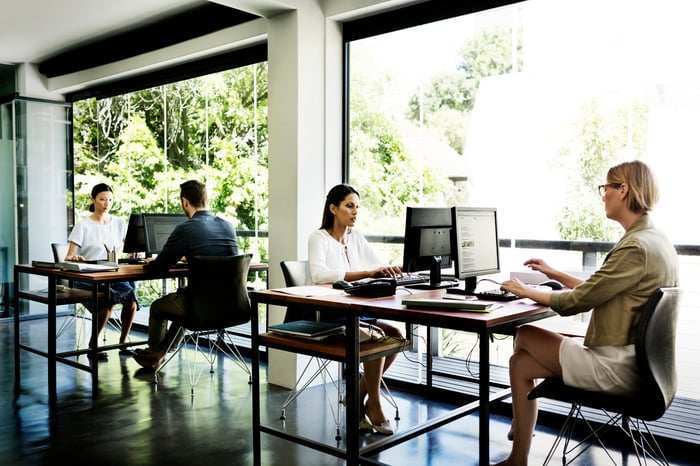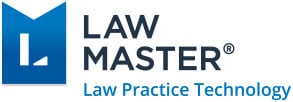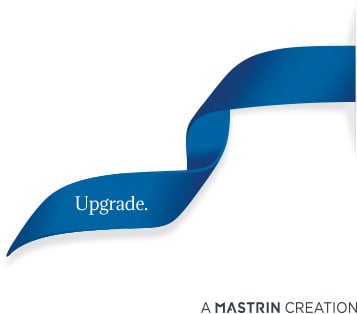LawMaster's Guide to Workplace Wellness
Lawyers offices are often known for their sense of prestige and respect for the way that things have always been done. However, there are many ways in which improving your office layout can lead to a more productive, healthy and efficient workforce. One method of improvement is by implementing a practice management software such as LawMaster.
Practice Management Software is useful for:
- Electronically filing and managing documents
- Integrating with your smart device to allow you to work on the go
- Making your office Paperlite or paper free
- Improving in-house communication
But let's take a look at some of the other ways you can improve on what you've got.
A Paperlite Office
As was previously stated, Lawyers, especially those who have been in the profession for quite some time, like to do things how they have always been done. Not to say they are stuck in the past, rather, something works for them so they don't change it. They're used to having files and briefs printed for them so they can be read and marked as they see fit. These files are then delivered to other parties by hand, who then go through the same process. The documents are signed and returned, again by hand to the sender. This leads to Law offices requiring vast storage areas for filing cabinets, on top of this, they need blocks of printers and scanners as well as areas to store trolleys required to carry stacks of briefs.
The process is extremely inefficient, for both time and space utilisation. In most senses, it is not an intelligent solution. There are many ways to improve physical file storage and even completely remove it from your office. LawMaster's Paperlite solution has been immensely popular in helping Legal Practices to improve their space utilisation and reduce costs. For example, LawMaster has saved Anderssen Lawyers 73.1% on printing costs, 53.2% in IT and Technology costs and 20% reduction in fees to clients with no reduction to profits.

Our Blog
We have gone into greater depth on each one of these topics in the LawMaster blog. Click here to go to the downloadable document.
Office Layout
Traditional Lawyer's offices are often segmented in similar ways, partners have their own closed offices, their personal assistants are seated outside their door or close by. Admin or reception staff are generally situated at the entrance to the firm where they can greet anyone entering the office. Junior lawyers, depending on the size of the firm, are seated in a bull pen of sought where each individual has a cubicle. These offices are designed primarily through hierarchy and order. They give the employees a sense that they have their own space but at the same time it is claustrophobic. This is justified by allowing them to make the space their own with a few personal knickknacks.
The issue with these layouts is that they are outdated and unproductive. They rely too heavily on individual achievement rather than innovation. A modern office layout should be designed around:
- Openness
- Communication
Utilising these should lead to work being done in the most efficient manner. An office bogged down by excessive clutter and storage is bound to fall short in the productivity department.
An open office is one that is free from material clutter. This includes filing cabinets, shelves and draws. Spaces should be opened up in both a physical and metaphorical manner. Employees should be not only allowed, but encouraged to discuss work tasks. After all, a second or third opinion could be exactly what they need in order to complete a task they've been struggling with.
A popular way of doing this is with a hot desk solution. Employees enter a 'pool' of desks each day and choose whichever they feel like sitting at. These desks are not covered in the material clutter that traditional cubicles have. Some might think that this is likely to decrease employee mood and productivity. However, studies have shown that the regular seating change removes the stagnation from a work space. Similarly, this movement allows employees to sit next to others they usually might not get the chance to. This will allow them to determine who they do and don't work best with. Behaviour has been shown to be contagious. If you seat a top employee next to one who tends to chat a bit more, studies have shown that the chatty employee will tend to adapt their behaviour to mirror the top employees.

However, there is such thing as too much communication, therefore it is imperative that you have designated quiet zones. These could be booths where employees can go to do private work without distraction, or areas where important conversations can be held on the phone.
Furthermore, walkways between departments should be designed to encourage chance meetings. Employees should have the opportunity to have discussions with people from other departments, it may be just what they need to break down a roadblock in their work. Inspiration is often found where we least expect it after all.
The metaphorical sense regards the communication aspect; your workplace must be open to discussion. Employees should feel safe to challenge each other, or even their superiors on certain matters. This is extremely important for work place relationships and the overall mental health of employees. Communication is an excellent stress reliever and a stressed workforce is an inefficient workforce. This is easier said than done and you need to begin to integrate communication as part of your work culture. Ensure that your employees understand the importance of communication and that they shouldn't be wary of it. Show that you care about what your employees have to say and they'll repay you with their hard work.
When formulating strategies for work, though it may seem that younger lawyers don't know as much as you do, their opinion is still valid. There is every chance that their to approach an issue may be more effective than yours. Don't be afraid to put on:
- Working lunches
- Workshops
- Training days
- Inter-department seminars
All of these will, over time, make employees more comfortable with interacting with each other and with senior staff. Communication can also be facilitated through your practice management solution. Ensure that yours optimises internal communication. Memos and follow ups help to remind employees of tasks they might have to do or company events they must attend. LawMaster also allows for intuitive storage of emails staff members receive so that they can simply locate and refer to them at a later date.
Design for your Employees Wellness
It's all well and good to discuss why everything within the office should be designed around what is most efficient. However, workplaces should also encourage physical activity. 'Presenteeism' or the practice of showing up to work in spite of medical problems, costs the Australian economy an estimated $34.1 Billion a year. These medical problems include but are not confined to: back pain, headaches and mental illness. As discussed previously, communication can help to improve mental health of employees. However, another solution is to ensure your office is filled with natural light, add windows and skylights wherever possible. Not only will this help with ensuring your employees get enough Vitamin D but their moods will be improved, we'll discuss this in greater detail later on.
Regarding headaches and back pain, there are many solutions to these ailments. Standing desks have become increasingly popular in recent years. "Sitting is the new smoking" is often thrown around, and for good reason. Studies have shown standing instead of sitting can:
- Improve weight loss
- Reduce the risk of heart conditions
- Lower blood sugar levels
- Help with back pain
- Improve mood and energy levels
It is possible to get standing desks which can be placed on desktops and can convert between sitting and standing heights. This is a great alternative to committing to one or the other, these are generally relatively inexpensive as well. This saving is twofold, firstly the obvious in that you will spend less on the facilities themselves. Secondly, a healthier workforce means your employees will require less sick leave and will work with greater efficiency. As has been said, presenteeism has a strong affect on Australian businesses. Any change you can make to your workplace to prevent this will have positive outcomes. Standing desks may take a little time to get used to but attitudes tend to change quickly as results are noticed.
The top of your computer screen should be just around eye level to prevent slouching. A good posture will help you get the most you can out of LawMaster's practice management software.
Making your Office Green
Focusing on biometrics, though important, is not all you must consider. Ensuring your employees are eating healthily and exercising will make them feel better, but you must go beyond that, think about everything in your office down to the air you breathe. That's right, it's time to consider just how clean and green that air in your office is. Depending on what kind of climate your practice is in you'll generally focus on your air conditioning, is it hot or cold enough? But have you considered if this air is being ventilated properly to the right areas of your practice? Is this air high quality? Where is the air being drawn from and how is it being filtered? All these factors are extremely important when considering your office design.
Researchers from Harvard recently undertook a study into air quality in offices. One focused on regular office conditions with standard ventilation, CO2 and general office place emissions. The other workplace was in a "green environment" in which air quality was improved and other emissions were reduced. To their surprise the Green office conditions had employees performing cognitive tasks 61% better than those in regular office conditions. If this productivity increase hasn't convinced you, it's time to look at the health benefits this can bring to your office.
Many office management teams are of the belief that greenery belongs outside the office. Some offices will keep a few fake plants in to "brighten the room" but it's rare that an office will have more than 1 or 2 small house-plants. The presence of plant-life in your office has several effects on employees. Firstly it acts as a natural filter for your air, removing the Carbon Dioxide and replacing it with breathable Oxygen, that little molecule we need to survive. This helps to remove headaches in workers and remove feelings of tiredness. Furthermore, it helps prevent symptoms of illness and provides and all-round boost to workplace health also known as improved "buildingomics". For those who are unfamiliar with this phrase, buildingomics are the factors in buildings which effect the health of those within it. As stated before it also helps workers perform cognitive tasks better, providing higher quality work in less time. Research into Green buildings has shown significant improvements to them in the US, it found:
- 26.4% higher test scores in cognitive tasks.
- 6.4% higher Sleep Quality scores.
- 30% fewer symptoms of illness and discomfort.
Green offices effect your employees outside of offices hours too. As has been shown, the improvement in sleep quality is fundamental to how employees will perform on a daily basis.
It's understandable that at this point many business owners may feel they need to improve their internal office air quality, but fear that will be an expensive exercise. However, research in the US has shown that a spend of merely US$40 per person in the office per year can result in a productivity increase of US$6,500. Those numbers really speak for themselves. This in combination with other techniques can add tremendous value to your firm. Take for example this in combination with LawMaster's intelligent practice management software which can improve your firms productivity by at least 30%. The potential for productive work increase in your daily proceedings is truly remarkable.
Light up That Space
When it comes to lighting, there is a lot to think about: positioning, brightness, cost, environmental friendliness, amount as well as natural vs artificial and a whole lot more. But to what degree do these factors effect your employees and the work they do? The answer to that is, a great deal. Energy-saving bulbs have been all the rage in recent years and for good reason, they require less power to work and last considerably longer. However, there is a much more environmentally friendly solution that is gaining traction, and that is natural light.
Psychologists have done a lot of research into how lighting effects people in the workplace and unsurprisingly it has a long list of benefits for your employees.
Firstly, there is a strong connection between a workers exposure to natural light and their, sleep patterns, mood and general quality of life. As was previously stated, it's important to think about how the environment effects your workers outside the office just as much as in. These outside experiences impact their in-office performance heavily.
Think of how many times you've woken up before work and you've had a little less sleep than usual. Remember how you felt gluggy and slow getting ready, how the sun burnt your eyes a little as you stepped outside. Your commute to work seemed a longer and had more stops than usual. Then throughout the day; things frustrated you more and your brain didn't seem to be able to comprehend things as quickly.
You felt slow, angry and frustrated, all because you slept less than you usually would. Now imagine if your workplace catered directly to combating this. To making sure that you woke up on the right side of the bed every morning and that you were ready when you went to sleep every night. How much better would you feel about going to work each day?
This is the power of natural light. Your body is effected by circadian rhythms. These are the ways in which your body responds to light exposure within environments. These dictate hormone release, sleep cycles, body temperature and many other important functions. In layman's terms, they control when you wake up and go to sleep and make your body release important hormones in response.
The issue with working in an office full of fluorescent light is that your brain is continuously being told that it is day time. You may realise it isn't, but your body subconsciously does not. Therefore, up until whenever you leave the office, which most of us know, generally isn't 5pm, your brain is constantly telling your body it isn't time to sleep soon. This is one of the biggest causes of sleep disorders and is most likely a part of the reason you or your employees are stuck lying awake at night (that or one too many double shot coffees after 6).
So how can you fix it? Glorious natural light. Fit skylights, remove cubicles and create a more open workplace, replace corner offices with glass board rooms, let the light in to your office. That's not to say that you should remove artificial light entirely, there are far too many logistical and safety reasons not to do that. Rather, where you can have natural light, put it in, within reason of course. By no means should you be blowing out your budget to tear out walls and create new lavish spaces, you should be looking at what you can do and doing your utmost to implement it.
![]()

Finally, It is important to note that changing just the lighting in your firm will have no great impact. It's important to make this change in conjunction with other factors. This includes layout, ventilation and all other points made in this article. Though the most important of all is ensuring that you have implemented an intuitive practice management solution such as LawMaster. LawMaster's Electronic Documents and other Paperlite solutions can reduce space needed for storage and help you save money on office supplies. This money can then in turn be used to make changes to your workplace layout. Take for example Anderson Lloyd who achieved a 100% reduction in paper usage by implementing electronic invoicing which in turn allowed them to move forward as a more sustainable practice and remodel their business. These methods in combination can do a great deal for your practice and will lead to healthier and happier employees.





